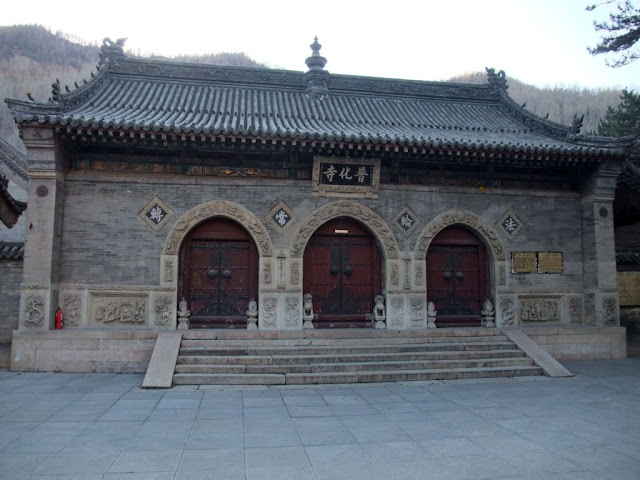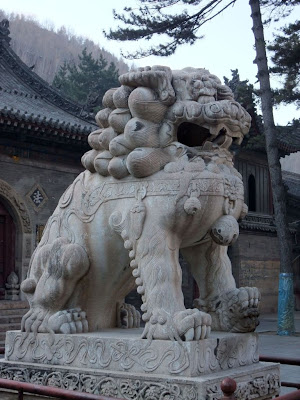
The structures of Temple Puhua-si (普化寺) was built in year 1925 during Mingguo period (民国) on a remaining site of Dishi-gong (帝释宫) which was also known as Yuhuang-miao (玉皇庙) in Ming Dynasty (1628-1644). Nobody knows when was the site of Temple Puhua-si first found. It was said that the founding of this site should be slightly later than Wutaishan's earliest temple Dafu-lingjiu-si (大孚灵鹫寺) presently known as Xiantong-si (显通寺). Basing on the Anduo History text (安多政教史) they suspect that Puhua-si was the former site of Taertan-si (塔尔坦寺又名龙台寺) as the record stated that there was an old castle enshrined with Buddha images in three halls and with abundance of Tibetan Sutra and books. Emperor Yongle (永乐帝) of Ming Dynasty when once came here to seek for talented men, he fell sick and vomited yellow water with blood. He thus expanded the temple and named it as Tuhua-si (吐花寺). A pavilion to Heavenly Jade Emperor Yuhuang-Dadi (玉皇大帝) was later added to the site making it well known as Yuhuang-Miao.



The construction history of Temple Puhua-si although was the shortest in Wutaishan, it has many celebrated monks with great achievement in the temple. Its abbot Rev. Miao-Sheng (妙生法师) was a famous Chinese calligrapher, who is capable to write with his left and right hand at the same time. His master Rev. Zang-Ming (藏明法师) was a medical physician to human's body and mind. Monastic community of monks are all his patients. He cured sickness, provide medicine and ease the pain of Sangka members. He was as if opening a Buddhist Clinic in the Temple. He is very specialized in xxxxxxxxxxx and used to unselfishly transfer all his skills inherited from his family to those who have interest in it, including lay people. Rev. Zhang-Ming is the disciple of Master San-Yi (三义大师) from famous Huayan Temple in Datong (大同华严寺). He came to Wutaishan in 1950s and carried on the repair and restore work of old temples. Temples Xiangdong-si, Dailuo-Ding, Wanfo-ge and Guangyin-Dong were some places he worked before. He took 3 years leading group of Sangha members to restore and repair 130 structures in Puhua-si including Main Shrine Hall and the Front Celestial Kings Pavilion.


Temple Puhua-si is a way-place for Pureland Buddhism. The awesome stone lions displayed at the front Celestial Kings Hall where the images of four Celestial Kings and a stone carved figure of Dharma Protector Weituo Pusa (韦陀菩萨) are enshrined. The hall has 3 huge arch doors with attractive stone carvings and the votive tablet with an horizontal inscription of three Chinese characters of Puhua-si framed up with stone carvings is placed over the top of central door. The four Chinese characters "法轮常转 Turn the Dharma Wheel Always" was written on the wall.



The screen wall made from brick and stone at Puhua-si is the longest in Wutaishan. It is another piece of architectural art in Wutaishan besides the one at Temple Longqian-si (龙泉寺).


One side of the screen wall was carved with three gods of Blessing, Prosperity and Longevity (福禄寿) at the center with Chinese folks legends Wen-Bi-Wuzi (文别五子) and Fanxi-qiuxian (番溪求贤) on left and right. The Images of Goddess of Mercy with Sudhana and Dragon Deity (观音菩萨,善财童子和龙女) are carved on the other side of the wall.



The site of Temple Puhua-si covers a land area of about 18900 sq. meter with more than 100 structures and verandas by two sides of the 4 main halls that are built along the central axis. Followed by the Front Hall of Celestial Kings is the Main Shrine Hall, Three Buddha Hall and the Sleeping Buddha Hall is at the back.


The Main Shrine Hall of Temple Puhua-si is a splendor and variegated building. The Hall enshrines Three Sages of Huayuan (华严三圣) Buddha Piru-zena-fo, Bodhisattva Manjushri and Samantabhadra (华严三圣:毗庐遮那佛,文殊师利和普贤菩萨) with sculptures of 18 Arahats at both sides and large area of murals at the wall depicting the life of Buddha Sakyamuni from a prince to enlightenment. The interesting figure is the old version image Bodhisattva Manjushri with long beard, offered at the back corner of the hall.



The gorgeous and delicate carving decoration of Main Shrine Hall.



The Main Shrine Hall faces west and to its north and south direction are 30 over two storey structures including halls for prayers and chanting and living quarters for the monks. A white Stupa somewhere near the corner was believed to be the tomb for the venerable monks.



Temple Puhua-si was built by the disciple of Rev. Puji of Nanshan-si with contributions from public. Many of the legends on stone carvings are similar to Nanshan-si, had great influences of Taoism and Confucianism.




The beautiful carvings of its pillar stone base.


The interesting stone carvings depicting Chinese folk legends and their daily life.


Some of the outstanding stone carving arts.














Temple Puhua-si was situated in a scenic environment with mountains at the back and River Qingshui-He flowing in front. In year 1996, one of the Shanxi photographer discovered that the 3000 meters long mountain ranges appear exactly like a sleeping Buddha with two hands on top of his abdomen and two feet stretch straight stepping on the South Mountain.


A true scenic sight.


Short Distance away from Temple Puhua-si and Nanshan-si at Xixian Valley (栖贤谷), lies a squarely constructed Tibetan temple called Xixian-si (栖贤寺) which more commonly known as Guanyin-Cave (观音洞), as there is an image of Guanyin at the limestone cave behind the Main Hall. Holes are found at the left and right side of mountain wall and people treated the water dripped off and collected from the left hole as holy water. This was the place where Dalai Lama the 6th and 13th once did their meditation and retreat.



Temple Xixian-si was believed to be first established in Ming Dynasty and rebuilt in Qing Dynasty during the reign of Emperor Kangxi (1662-1722). It was a pilgrimage site for Dalai Lama to do their worship and sutra reciting. The yellow painted temple winded up by red brick wall and hanged at a mountain cliff, was an eye-catching structure from distance. The principal Image enshrined in the Main Guanyin Shrine Hall is Bodhisattva Guanyin. By his two sides are images of Bodhisattva Manjushri, Samantabhadra, Maitreya and Tsong-kapa.


The magnificent view from Feilai-Ting (飞来亭), a hexagon Pavilion stands along the steep way while you climb up the narrow stone steps towards the Main Shrine Hall. The Pavilion was also widely known as Guanyin-Ting (观音亭) as drawn on the cross-beams of the pavilion are three paintings that depict the stories of how Goddess of Mercy showed compassion and rescued people from disasters and sufferings.



Crossing River of Qingshui-He (清水河).


No comments:
Post a Comment